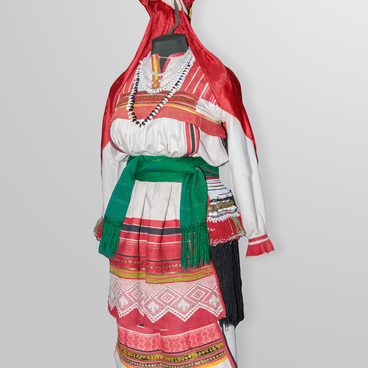The costume of the southern group of Mordovians is spread on the territory of Insarsky, Kovylkinsky, Kadoshkinsky, Ruzaevsky and part of Krasnoslobodsky districts of Mordovia and the neighboring villages of Mokshansky and Narovchatsky districts of Penza region.
Since ancient times there has been a strong tradition of coloring clothes, adding bright spots to them. Shirts were made of the finest, well-bleached canvas, and in the 20th century, cotton fabrics were used. It was typical to wear shirts with sleeves made of colored cotton fabric with red and white checks, and later — of chintz with a fine pattern. The color scheme of clothing changed greatly in the middle of the 20th century. New forms of clothing made of multicolored factory fabrics appeared. The figural and color image of the costume was supplemented with the sound of many pendants made of bells, small silver coins, and tokens, the ringing of which merged into the characteristic music, tuned to the rhythms of human movements. The length of the pendants, which the Mordovian woman included in her costume, determined the strength and timbre of the sound of bells. The costume of the southern group of Moksha fully justifies the saying: “You first hear a Moksha woman, and then you see one”. The melodious chime was meant to protect against evil spirits.
The Moksha women’s costume is distinguished by characteristic techniques in putting on and wearing a multi-piece ensemble of clothes. The traditional festive ensemble includes several shirts. Depending on the financial standing of her family, a woman could wear three or more shirts. The clothing indicated not only the skill of its owner, but also the prosperity. The upper one, the most elegant shirt, had a broad embroidery on the sleeves, which ran in a strip from shoulder to cuffs. A colorful panar shirt is a masterpiece created by the hands of Moksha women. Made just for everyday life, it strikes with its meticulous workmanship. Before sewing a shirt, a seamstress embroidered its parts. She determined the front and back halves of the shirts, distinguishing them by the type of embroidery. All decorative designs in the completed shirt had to fit together in the pattern. The upper shirt ozha ki (literal translation — road of a sleeve) was a masterpiece of embroidery art.
The distinctive splendor of southern Mordovian costume combines outstanding folk talent, a generous abundance of decorative features, and ancestors’ traditions.
Since ancient times there has been a strong tradition of coloring clothes, adding bright spots to them. Shirts were made of the finest, well-bleached canvas, and in the 20th century, cotton fabrics were used. It was typical to wear shirts with sleeves made of colored cotton fabric with red and white checks, and later — of chintz with a fine pattern. The color scheme of clothing changed greatly in the middle of the 20th century. New forms of clothing made of multicolored factory fabrics appeared. The figural and color image of the costume was supplemented with the sound of many pendants made of bells, small silver coins, and tokens, the ringing of which merged into the characteristic music, tuned to the rhythms of human movements. The length of the pendants, which the Mordovian woman included in her costume, determined the strength and timbre of the sound of bells. The costume of the southern group of Moksha fully justifies the saying: “You first hear a Moksha woman, and then you see one”. The melodious chime was meant to protect against evil spirits.
The Moksha women’s costume is distinguished by characteristic techniques in putting on and wearing a multi-piece ensemble of clothes. The traditional festive ensemble includes several shirts. Depending on the financial standing of her family, a woman could wear three or more shirts. The clothing indicated not only the skill of its owner, but also the prosperity. The upper one, the most elegant shirt, had a broad embroidery on the sleeves, which ran in a strip from shoulder to cuffs. A colorful panar shirt is a masterpiece created by the hands of Moksha women. Made just for everyday life, it strikes with its meticulous workmanship. Before sewing a shirt, a seamstress embroidered its parts. She determined the front and back halves of the shirts, distinguishing them by the type of embroidery. All decorative designs in the completed shirt had to fit together in the pattern. The upper shirt ozha ki (literal translation — road of a sleeve) was a masterpiece of embroidery art.
The distinctive splendor of southern Mordovian costume combines outstanding folk talent, a generous abundance of decorative features, and ancestors’ traditions.




